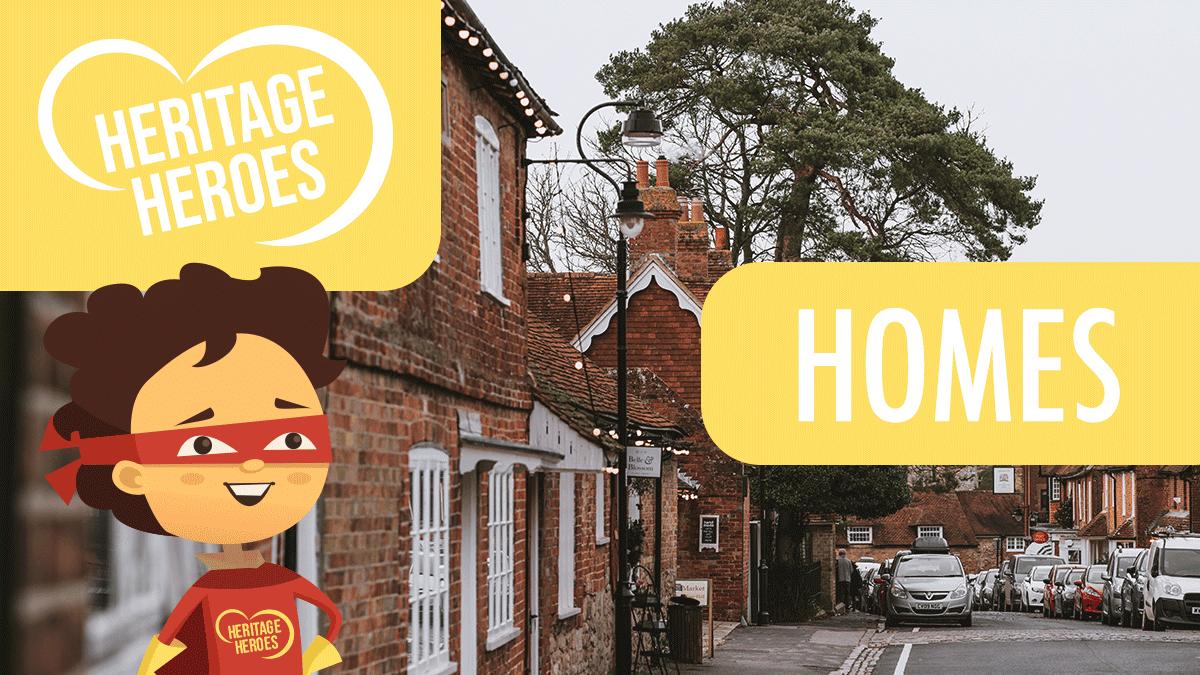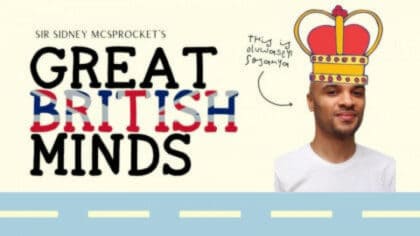Wherever you live, there’s treasure to be discovered!
Not just gold and gems, but stories of buildings, locations and people.
Our heritage is a great wealth… and it’s all around us. Sometimes standing proud in the open air – sometimes hidden behind some bushes.
And to help find it, we’re looking for Heritage Heroes – could you be one?
You can find clues in all sorts of places to find out what happened in your street, neighbourhood and further afield, from famous visitors to historic events.
Here are three tips to help you become a Heritage Hero…

HERITAGE HEROES. AN INSPIRING AUDIO PRODUCTION FOR FUN KIDS. MADE POSSIBLE WITH THE NATIONAL LOTTERY HERITAGE FUND, WITH THANKS TO NATIONAL LOTTERY PLAYERS.
Different Types of Houses
Next time you’re walking to school, a shop or seeing friends, have a look at the different types of houses around.
Are they all the same or is there a mix?
Tudor Houses
In Tudor times, most homes were half-timbered with white-painted walls made of something called wattle and daub – a combination of wet soil, clay, sand, straw and… animal dung!
Town houses would have had steeply-pitched roofs and small-paned casement windows, whilst in country areas, roofs would have been thatched using reeds or straw.
As well as being home for several generations of a family, you probably would have also shared the space with animals.
You can see some examples of black and white Tudor houses across the country, especially in villages like Pembridge in Herefordshire.
Georgian Houses
By the year 1700, after the disaster of the Great Fire of London, most houses were built of brick; they were more flat-fronted, with sash windows and some gothic touches.
And if we fast forward to 1800 and the Georgian home – they’re similarly flat fronted with sash windows – but light and airy in style – and with many more decorative touches like fanlight windows over a six-panelled front door.
You sometimes see Georgian houses with bricked up windows – that’s because of a window tax levied to help fund the army, so thrifty people just bricked up their windows!
Things that can help you discover your area’s heritage
Have a look at old photographs – look online or in your local library. Look at what they show – perhaps old buildings and cars; and check out what people are wearing
Check out old newspapers – again, check them out in your library
Look at old archives and local records
Listen to some audio recordings – and why not make your own, record your neighbours memories of the local area
Victorian Houses
Into the Victorian era and houses had bay windows, coloured brickwork, decorated bargeboards and roof tops, and a garden back and front.
This was the time of the emerging middle classes, who lived in substantial detached, semi or terraced homes – still large enough to have servants.
With a greater influx into cities, homes started to become more standard. More and more terraced houses were built, with perhaps several builders building along the same street – hence why there’s sometimes blocks of similar but different terraces.
Sometimes, an employer would build houses for their workers, like the Great Western Railway village in Swindon and Cadbury’s Bournville Village in Birmingham.
In poorer areas, where space was tight, houses were built back-to-back with a communal yard and toilet.
You can see examples of back to backs in Birmingham and at the Black Country Living Museum!
20th Century Houses
At the start of the 20th century, as new railway lines expanded into the countryside, the railway companies often built new communities to provide customers for their lines.
London’s Metroland had spacious homes, with gardens and tree lined streets. And many homes were decorated in the Arts and Crafts style – featuring gentle designs and art from nature.
The next big change came after the second world war when cities had to rebuild.
Many old Victorian houses were pulled down and tall blocks of flats were built in concrete, with large windows and balconies, and all sorts of modern facilities.
Whilst many of these tower blocks have been pulled down, some remain – like Park Hill in Sheffield, a brutalist concreate structure now protected as part of our heritage. Park Hill was created in 1961 to create a new community for families. Its distinctive ‘streets in the sky’ were wide enough for a milk float to do doorstep deliveries.
Working In The Home

You might think homeworking is a relatively new concept, but people have been working from home for hundreds of years. In the 18th century, women and children in the Black Country made hand-hammered chains in cramped outbuildings next to their homes. Many also used to make matches in their kitchens.
Over the centuries, country doctors and vets would have lived in houses with rooms for their surgeries, and caretakers’ houses can still be seen in the grounds of some schools.
And today, many vicarages are still homes and places of work for vicars.
Now it’s over to you! Here’s a reminder of things to look for to help you find out about the place where you live.
1 – Next time you’re walking around where you live, have a good look at all the different types of houses. See if you can guess when and why they were built.
2 – Check out what work might have been done from a home – you might be able to tell from its name or if there’s a second front door.
3 – And check the street furniture around your home – things like street lights and post boxes – you can age them by the royal insignia. Also, check old manhole covers – in the past they might have been made locally.
Here are some helpful links that will help you become a Heritage Hero!
Check out old Town Maps: www.townmaps.history.ac.uk/
And watch some old Films: www.bfi.org.uk/archive-collections
Read old newspapers: www.britishnewspaperarchives.co.uk
Learn More about Heritage Sites: www.heritagegateway.org.uk
Learn more about Birmingham’s history: www.nationaltrust.org.uk/visit/birmingham-west-midlands/birmingham-back-to-backs
Learn more about the home: www.museumofthehome.org.uk/








